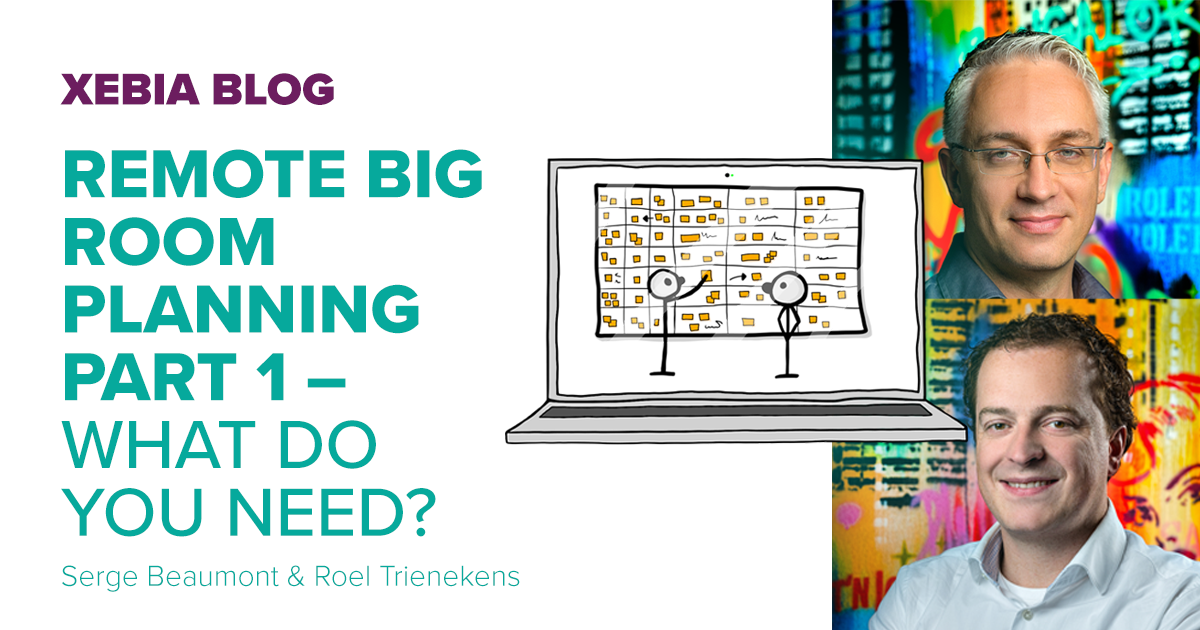One of the main reasons to hold Big Room Planning sessions is that you can discuss all work with everyone present and collaborate towards a plan supported by all those present. In these days of remote work that has become a lot more difficult. With a little bit of preparation and some clear agreements you can still achieve the same outcome with the same group.
This article is written by Serge Beaumont and Roel Trienekens, both Senior Business Agility Consultants.
You can achieve clear agreements by structuring the flow of your conversations in your remote working tool of choice. Set up a shared collaboration space, allow access for all to all files and documentation you need – and last but not least properly prepare for and facilitate the event. When taking proper care your Big Room Planning sessions can be just as effective as if you were physically in the same room.

Challenges
Since working remote has become the new normal, our Big Room Planning sessions lack a key ingredient, which is the Big Room. This brings several challenges. The first is that all the various forms of communication that being together in the same spot bring us are no longer there, the very reason we did the planning in the Big Room in the first place.
In order to make your Big Room Planning meeting effective, the following challenges need to be overcome:
- An unmoderated group conversation is much more difficult, since a lot of our communication depends on non-verbal and/or visual signals we send and receive.
- Taking a step back and looking at the bigger picture is not so simple on a small screen.
So effective Remote Big Room Planning requires that we mitigate both these challenges.
Your Toolkit
All the elements that make a well-run physical Big Room planning effective need a virtual counterpart. You’ll at least need the following tools:
Video connection
A place for having face-to-face conversations accompanied with video. The problem with having video conversations in large groups is that the bottleneck is the audio channel. When collaborating remotely, it is almost impossible to have conversations when there are multiple people talking. Yet having only one person talking at a time severely limits the effectiveness of your communication. So your tools need to support at least the following:
- Breakout rooms with video, with a maximum group size of 4-6 people, so all participants can contribute in the same virtual room or call.
- The ability to easily switch rooms in case ad hoc conversations or alignment session are needed.
- Supporting communication with chat capabilities.
Commonly used tools such as the now widely used Zoom and Microsoft Teams have all these features available.
Shared collaboration space
Next, you need a space to collaborate virtually on whatever it is that you are producing. In this case that means a virtual planning board of some sort, along with a place for supporting other boards, lists or documentation. We call this the Common Canvas. Your tool needs to support at least:
- Access to all information for all participants (no handovers, or ‘only one person can enter or edit information’).
- Allow for simultaneous editing by all participants and real time updates of those changes.
- Allow for easy structuring of the information. Effective collaboration requires entry, adjusting and structuring information. You do not want the bulk of the time to go into dragging, dropping and moving information around just to make sure that we still see the bigger picture.
- Templates that support the information structure. Premade boards for the planning, impediments, action points and/or a parking lot all make it easier to make the information structured and easy to access for all.
Although this can be done with Excel sheets, Powerpoint presentations or Word documents, it is highly recommended to make use of virtual whiteboards, such as those offered by Mural, Miro or Nureva Span.
In case you do want to collaborate on Microsoft Office Documents, be sure to use the browser (Office 365) version of these tools, as they support simultaneous editing.
Solid internet connection for all participants
A solid setup at home for all participants to make sure that everyone can participate properly, this includes:
- A solid internet connection that support video streaming.
- A dedicated working space where you can speak freely without being disturbed.
- Proper equipment. Headphones to prevent feedback of audio is mandatory and a good microphone is recommended.
Access for all to all files
Access to all required information. Nothing slows down a collaborative effort like having to ask permission to access files, or having to wait for that key colleague because he or she is not aware of the day’s agenda.
Time to get started
Now that you have your toolkit in order it is time to look at what goes into the organization of the event itself. In part 2 we will discuss how to prepare, how to host the day itself and how to wrap up such an event. This way you will have everything you need to still do Big Room Planning events, even if the physical Big Room stays empty for now.
By any questions please get in touch with Serge Beaumont (06-23813925) or Roel Trienekens. Or download the Big Room Planning Flyer.
And do you want to learn more? Join the Scrum@Scaling, Certified SAFEe 5 Product Owner/Product Manager (SAFe PO/PM) or Certified SAFe 5 for Teams (SAFe SP) training online and use the virtual classroom as well. Our courses and locations have been aligned to support distance learning.




